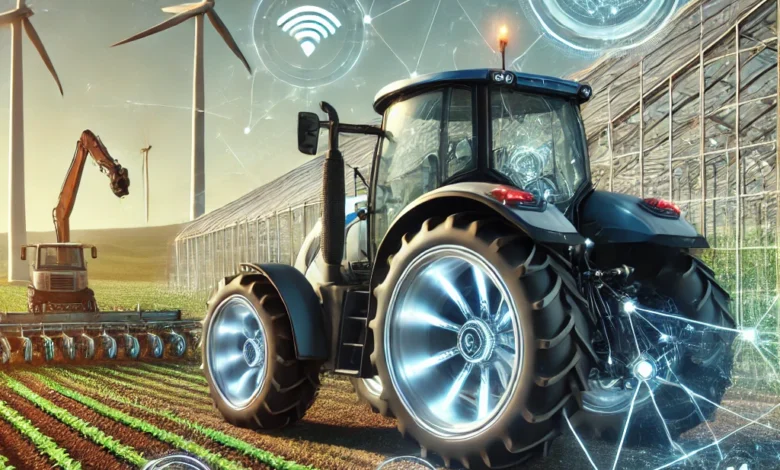The Future of the Tractor Business in 2025: Trends, Innovations, and Market Insights

The tractor industry has always been a crucial part of global agriculture, enabling farmers to enhance productivity and efficiency. As we move into 2025, the business landscape for tractors is evolving rapidly, driven by advancements in technology, shifts in market demands, and a growing focus on sustainability. This article delves into key trends, innovations, and market insights shaping the tractor business in 2025.
Future of the Tractor BusinessTractor Business in 2025
The Growing Demand for Smart Tractors
One of the most significant transformations in the tractor industry is the rise of smart tractors. These machines are equipped with cutting-edge technology such as GPS guidance, IoT connectivity, and AI-driven automation, allowing farmers to optimize field operations with precision.
Key Features of Smart Tractors
- Automation & AI: Tractors with self-driving capabilities are becoming more common, reducing the need for manual labor and increasing efficiency.
- IoT Integration: Sensors collect real-time data on soil quality, moisture levels, and fuel consumption, helping farmers make informed decisions.
- Precision Farming: Smart tractors enable precision agriculture, ensuring minimal waste of resources like water, fertilizers, and pesticides.
The Shift Towards Electric and Hybrid Tractors
With the world prioritizing sustainability, the push for electric and hybrid tractors is stronger than ever. Traditional diesel-powered tractors contribute significantly to carbon emissions, prompting manufacturers to develop eco-friendly alternatives.
Advantages of Electric and Hybrid Tractors
- Electric Tractors: Battery-powered models offer a cleaner alternative, reducing greenhouse gas emissions and operational costs.
- Hybrid Tractors: A mix of electric and fuel-driven engines ensures efficiency while cutting down on carbon footprints.
- Government Support: Many governments worldwide are offering incentives and subsidies to encourage the adoption of green technology in agriculture.
Market Trends and Growth Prospects
The tractor market is experiencing substantial growth, with several key factors influencing its trajectory in 2025.
Factors Driving Market Growth
- Rising Mechanization in Agriculture: Developing countries, especially in Asia and Africa, are witnessing a surge in mechanized farming, driving higher tractor sales.
- Technological Advancements: Innovations in AI, automation, and energy efficiency are attracting more farmers to invest in modern tractors.
- Increasing Demand for Compact Tractors: Small-scale farmers and urban agriculture projects are fueling the demand for compact, multi-purpose tractors.
Challenges Facing the Tractor Industry
Despite its promising future, the tractor business also faces some challenges in 2025:
Major Industry Challenges
- High Initial Costs: Smart and electric tractors come with a hefty price tag, making them less accessible to small farmers.
- Infrastructure Limitations: In many regions, the lack of proper charging stations and maintenance facilities for electric tractors remains a hurdle.
- Market Competition: Established brands like John Deere, Mahindra, and Kubota are facing stiff competition from emerging players, leading to pricing pressures and innovation races.
The Role of AI and Data Analytics in the Tractor Business
AI and big data are revolutionizing the way tractors operate and how businesses make strategic decisions. Predictive analytics helps in preventive maintenance, reducing downtime and improving productivity. AI-driven platforms are also assisting manufacturers in understanding customer preferences, leading to better product development and customization.
Innovations in Tractor Manufacturing
The manufacturing process of tractors is also undergoing significant transformations in 2025, thanks to automation and robotics.
Key Innovations in Manufacturing
- 3D Printing Technology: Used for producing parts efficiently and reducing waste.
- Robotics in Assembly Lines: Enhancing production speed and accuracy.
- Sustainable Materials: Manufacturers are investing in biodegradable and recyclable materials for tractor production.
The Future of Autonomous Tractors
Autonomous tractors are expected to dominate the industry in the coming years, reducing dependency on manual labor and increasing precision in farming operations.
Benefits of Autonomous Tractors
- Labor Cost Reduction: Reduces the need for human operators.
- Increased Productivity: Works efficiently around the clock.
- Reduced Human Error: Ensures better accuracy in farming operations.
Financing and Leasing Trends in the Tractor Business
With the rising costs of modern tractors, financial solutions like leasing and flexible financing options are gaining popularity among farmers.
Financing Options for Farmers
- Government-Backed Loans: Various agricultural development programs offer financial support for tractor purchases.
- Leasing vs. Buying: Leasing tractors is becoming an attractive option for small farmers who cannot afford upfront costs.
- Subscription-Based Tractor Services: Some companies are now offering tractors on a subscription basis, reducing ownership costs.
Conclusion
The tractor business in 2025 is set for remarkable transformation, driven by technological advancements, sustainability initiatives, and increasing demand for efficiency in agriculture. While challenges exist, the opportunities far outweigh them, making this an exciting time for manufacturers, farmers, and stakeholders in the industry. As innovation continues, the future of tractors looks brighter than ever, ensuring sustainable and efficient farming for generations to come.
For More Article Visit: WitnessFuture